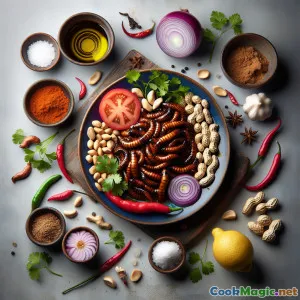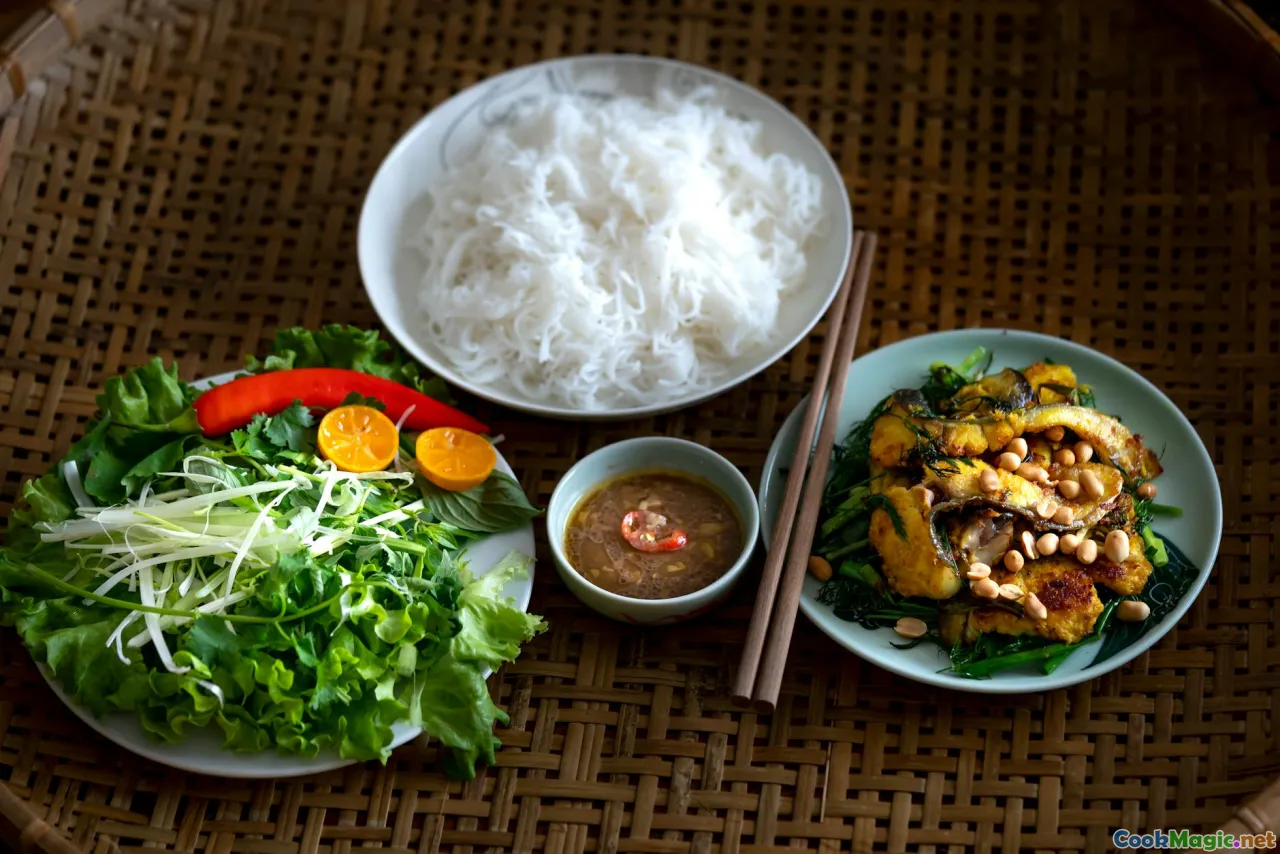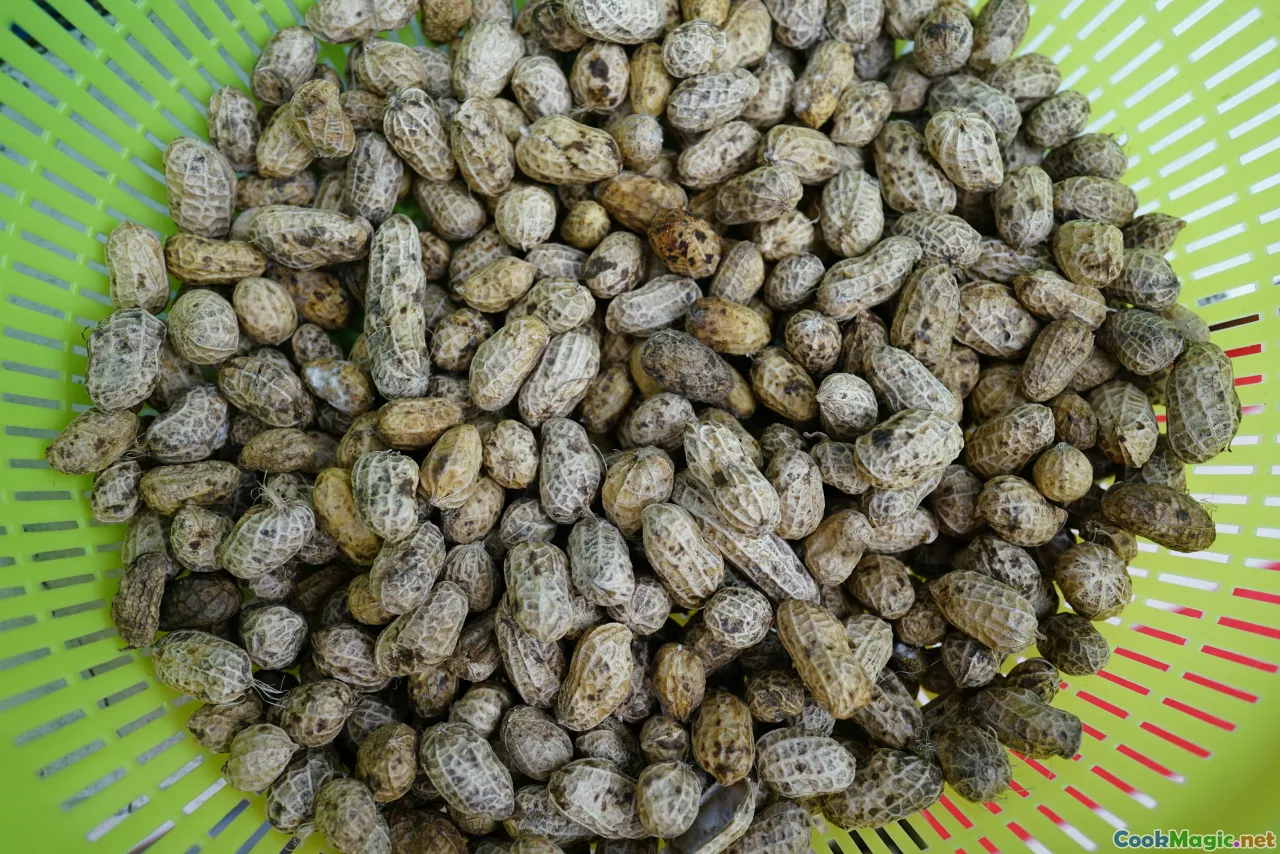
Mopani Worms in Lively Peanut & Spice Sauce
(0 Reviews)Ingredients
-
70 grams Dried mopani worms
(Available at African food markets; rinse before use.)
-
150 grams Salted peanuts
(Skinless; may substitute with raw groundnuts if unsalted are not available.)
-
1 medium Red onion
(Finely chopped.)
-
2 medium Tomato
(Roughly chopped.)
-
1 whole Fresh chili pepper
(Deseeded and minced; adjust for spice preference.)
-
2 cloves Garlic cloves
(Crushed.)
-
2 teaspoons Fresh ginger
(Grated.)
-
2 tablespoons Vegetable oil
(Preferably peanut or sunflower oil.)
-
1 teaspoon Coriander powder
-
1 teaspoon Paprika
-
1/2 teaspoon Salt
(To taste.)
-
350 ml Water
(Divided between worm boiling and sauce.)
-
2 tablespoons Fresh coriander leaves
(Finely chopped, for garnish.)
-
4 pieces Lemon wedges
(For serving.)
(Available at African food markets; rinse before use.)
(Skinless; may substitute with raw groundnuts if unsalted are not available.)
(Finely chopped.)
(Roughly chopped.)
(Deseeded and minced; adjust for spice preference.)
(Crushed.)
(Grated.)
(Preferably peanut or sunflower oil.)
(To taste.)
(Divided between worm boiling and sauce.)
(Finely chopped, for garnish.)
(For serving.)
Nutrition
- Servings: 4
- Serving Size: 1 plate (250g)
- Calories: 410 kcal
- Carbohydrates: 19 g
- Protein: 28 g
- Fat: 26 g
- Fiber: 6 g
- Sugar: 4 g
- Sodium: 540 mg
- Cholesterol: 0 mg
- Calcium: 80 mg
- Iron: 5.1 mg
Instructions
-
1 - Rehydrate Mopani Worms:
Place dried mopani worms in a bowl, cover with hot water, and soak for 10 minutes. Drain and rinse under running water until clean.
-
2 - Parboil the Worms:
In a saucepan, add worms with 250ml fresh water. Boil gently for 8–10 minutes, then drain well and pat dry.
-
3 - Prepare the Groundnut Paste:
Blend peanuts in a food processor until smooth and buttery. If necessary, add a splash of water for smoother consistency.
-
4 - Make the Base Sauce:
Heat oil in a large skillet. Add onions and sauté until translucent. Add garlic, ginger, chili, and continue for 2 minutes, stirring frequently.
-
5 - Add Tomatoes and Spices:
Mix in chopped tomatoes, paprika, coriander powder (if using), and salt. Cook down until tomatoes are soft and sauce thickens.
-
6 - Incorporate Worms & Simmer:
Add the boiled worms to the sauce and stir well to coat. Pour in groundnut paste and 100ml water. Simmer on low, stirring, until creamy (about 7 min).
-
7 - Taste and Adjust Seasoning:
Check seasoning, adjust salt or pepper to taste, and simmer another minute to blend flavors.
-
8 - Garnish and Serve:
Serve hot, garnished with fresh coriander leaves and lemon wedges, along with nshima, rice, or maize porridge.
Place dried mopani worms in a bowl, cover with hot water, and soak for 10 minutes. Drain and rinse under running water until clean.
In a saucepan, add worms with 250ml fresh water. Boil gently for 8–10 minutes, then drain well and pat dry.
Blend peanuts in a food processor until smooth and buttery. If necessary, add a splash of water for smoother consistency.
Heat oil in a large skillet. Add onions and sauté until translucent. Add garlic, ginger, chili, and continue for 2 minutes, stirring frequently.
Mix in chopped tomatoes, paprika, coriander powder (if using), and salt. Cook down until tomatoes are soft and sauce thickens.
Add the boiled worms to the sauce and stir well to coat. Pour in groundnut paste and 100ml water. Simmer on low, stirring, until creamy (about 7 min).
Check seasoning, adjust salt or pepper to taste, and simmer another minute to blend flavors.
Serve hot, garnished with fresh coriander leaves and lemon wedges, along with nshima, rice, or maize porridge.
More About: Mopani Worms in Lively Peanut & Spice Sauce
Mopani Worms in Spiced Groundnut Sauce: Explorations, Origins & Experience
Southern Africa’s culinary culture teems with bold flavors, unique proteins, and centuries-old traditions. Among its most iconic, and adventurous, delicacies is the Mopani worm—known locally as macimbi or madora in Zimbabwe—an edible caterpillar of the Gonimbrasia belina moth frequently found during the rainy season. High in protein and micronutrients, mopani worms are more than novelty: they’re central to rural livelihoods, revered for food security, and embraced by adventurous taste buds worldwide.
History and Cultural Roots
In Zimbabwe and parts of Botswana, Mozambique, Namibia, and South Africa, mopani worms have been both a food staple and a story of communal effort. For generations, the arrival of mopani caterpillars inspired forest excursions with family, taught preservation by drying or smoking, and culminated in festive, hearty meals. Traditionally, mopani worms are enjoyed snack-like—fried and salted over hot coals—or featured as the soul of a main platter, much like in this sumptuous spiced groundnut sauce version.
This recipe integrates native tradition with modern culinary techniques. Here, groundnuts (peanuts) form a creamy, deeply flavored sauce enriched by the gentle heat of chili and sweet tang of tomatoes—an echo of rural Zimbabwean kitchens. Each element speaks of resilience and adaptation, where every ingredient is valued, and nothing is wasted.
Unique Aspects: Taste & Texture
What sets this dish apart is its marriage of uncommon protein—mopani worms notorious for their chewy-yet-tender bite, earthy flavor, and nutty undertone—with the warm, enveloping comfort of a simmered peanut-tomato sauce. The skyline of flavors is expanded by ginger and fresh chili, upping the aromatic complexity. A lemon wedge served alongside provides the brightness that cuts through richness, making each bite harmonious.
Contrary to what some might assume, mopani worms, when prepared well, deliver a unique umami punch reminiscent of perfectly cooked shellfish or mushrooms. Toasting or frying before simmering enhances the flavor, but caution helps preserve moisture; overcooking may harden them.
Culinary and Nutritional Tips
- To Clean: It's critical to soak and rinse dried mopani worms. This rehydrates and softens them while banishing excess bitterness or grit.
- Vegetarian Adaptation: Substitute the worms with strips of firm tofu or seitan cooked in vegetable stock for a grounded, non-insect protein alternative.
- Serving Suggestions: Traditionally served with plain maize porridge (sadza or nshima), but it’s delicious over steamed rice, millet, or even crusty bread.
- Nutrition: Mopani worms offer a powerhouse of protein and micronutrients—zinc, calcium, and iron—making them a sustainable choice in combating malnutrition and as future-forward food.
Significance & Personal Touches
Preparing mopani worms can be a participatory, narrative experience, ideal for those committed to culinary adventure and sustainability. The first taste may surprise hesitant eaters, but the creamy groundnut sauce acts as a familiarizing bridge between edible insects and new palates. The lively spices and tomato mellow the earthiness, while a finishing touch of fresh herbs enlivens the plate.
This dish reminds us that the best recipes often emerge where tradition meets creativity. Mopani worms, once dubbed food for the poor, are now highlighted by innovative chefs worldwide and acclaimed for fostering novel food conversations. Trying this classic with a twist, you’re joining a vibrant movement—rethinking protein, revaluing what’s wild-harvested, supporting local ecology, and encountering global flavor in its boldest, most unfiltered sense.
Embrace the spirit of Zimbabwean hospitality: Serve it with enthusiasm, share stories of the ingredients, engage adventurous eaters, and celebrate the gift of cross-cultural feasting. Mopani Worms in Spiced Groundnut Sauce is a meal that defies boundaries, rewards boldness, and tastefully honors its enduring classic roots.




















